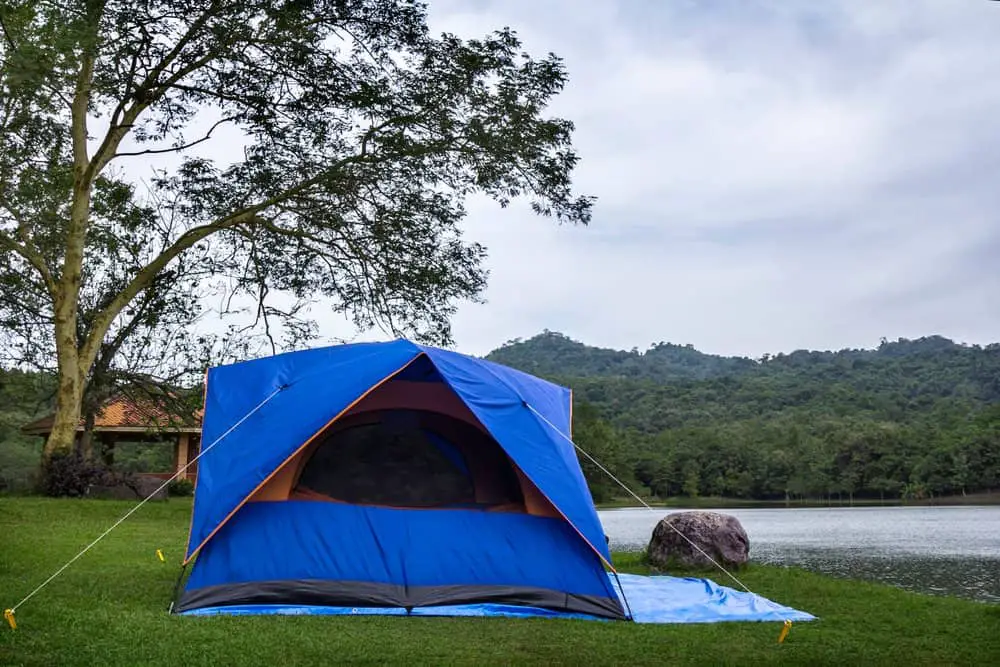Do You Need A Tent Footprint?

A tent footprint is an essential piece of gear for any serious camper or hiker. It serves as a protective layer between your tent and the ground and can help extend the life of your tent significantly.
Quick Links
What is a Tent Footprint?
A tent footprint, also known as a ground cloth, is a piece of fabric or other material that you place under your tent to protect the floor from abrasion and moisture. It also helps to insulate the bottom of your tent, keeping you warmer on cold nights.
Many people choose to use a footprint even if their tent already has a built-in floor, as it can add an extra layer of protection.
There are a few different materials that footprints are made from, but the most common is polyethylene. This material is lightweight and durable, making it ideal for use under a tent. Footprints come in various sizes to fit most tents, and they typically have grommets or stakes to keep them in place.
When Do I Need a Tent Footprint?
There are a few things to consider when deciding whether or not you need a tent footprint. First, think about where you’ll be using your tent. A footprint is a must-have if you’re camping on rough or uneven ground. You may not need one if you’re mostly camping on smooth surfaces.
Another thing to consider is the size and weight of your tent. Some footprints are explicitly made for specific tents, so make sure you get the right one. And finally, think about your budget. Footprints can be expensive, but they’re definitely worth the investment if you plan to do a lot of camping or hiking.
So, do you need a tent footprint? Let’s take a closer look at the advantages vs. disadvantages of a tent footprint and more.
Advantages Of a Tent Footprint
- It protects your tent from the ground. If you’re camping on rough or uneven ground, a footprint can help prevent your tent from getting damaged.
- It keeps the bottom of your tent clean. A footprint can help keep the bottom of your tent clean and free from dirt and debris.
- It helps extend the life of your tent. By protecting your tent from the ground and keeping it clean, a footprint can help extend the life of your tent significantly.
Disadvantages Of a Tent Footprint
- They are usually more expensive than a tarp.
- They are not as versatile as a tarp and cannot be used for other purposes, such as a ground cloth or sunshade.
- Finally, footprints can add weight and bulk to your backpack.
How Big Should a Tent Footprint Be
When deciding on the size of your tent footprint, you’ll need to consider both the size and type of tent you have. Most footprints are designed to fit specific tents, so getting the right one is important.
As a general rule, your footprint should be about the same size as your tent’s floor. If you have a smaller tent, you may be able to get away with a slightly smaller footprint. But if you have a larger tent, you’ll need a bigger footprint to make sure it’s fully protected.
Most footprints are relatively lightweight and shouldn’t add much bulk to your backpack when it comes to weight. However, some heavier duty footprints can be a bit heavier.
For example, a Tyvek tent footprint weighs roughly 14 oz. for a 7×9 sheet.
Why is it important for the tent footprint to match the size of the tent?
At first, you may think getting an oversized footprint for your tent is a good idea. After all, it will fully protect your tent and give you some extra room to play with. However, an oversized footprint can actually do more harm than good.
First of all, an oversized footprint can make it difficult to pitch your tent. If the footprint is too big, it will get in the way and make the process more difficult.
Secondly, an oversized footprint can create a lot of extra space underneath your tent. This can cause water to collect and create wet spots on the ground.
Lastly, an unnecessarily large footprint will add unnecessary weight and bulk to your backpack – and who needs that?
In general, it’s best to stick with a footprint that is the same size as your tent’s floor. This will ensure full protection without any of the drawbacks.
Tent Floor Durability And Waterproof Ratings
When you’re selecting a new tent, there are two crucial factors you need to consider: durability and waterproofing. The floor of your tent is the most vulnerable part, and if it’s not durable or waterproof enough, you could end up with a very uncomfortable — and wet — camping trip.
Waterproofing is measured in terms of hydrostatic head, which is the amount of water pressure that a fabric can withstand before water starts to seep through. The higher the hydrostatic head rating, the more waterproof the fabric is. A tent with a hydrostatic head rating of 10,000mm will be completely waterproof in even the heaviest downpour.
However, a good rule of thumb is to choose a tent with a hydrostatic head rating of at least 2000mm, which should be able to do the job in most cases.
As for durability, tents have what’s called a denier count. This is a measurement of the thickness of the fabric, and the higher the number, the more durable the tent will be. The average denier count for a tent is about 40D, but if you’re looking for something extra-tough, you can find tents with a count of up to 100D.
So what does this all mean for footprints? When it comes to durability and waterproofing, the thicker, the better, and the less of a need for a footprint.
However, depending on the terrain you’ll be camping on, a footprint may be necessary to protect your tent from sharp objects or abrasion.

Can You Use a Tarp As a Tent Footprint
In a word, yes. A tarp can be used as a tent footprint in a pinch, but it’s not as effective as a dedicated footprint. A tarp is less durable than most footprints and doesn’t provide the same level of protection. It can also be used for other purposes, such as a ground cloth or sunshade, which a dedicated footprint can’t do.
Ultimately, whether or not you use a tarp as a footprint depends on your needs and budget. If you’re looking for an inexpensive option and don’t mind sacrificing some durability, then a tarp is a good choice. But if you want the best possible protection for your tent, then go with a dedicated footprint.
How to make a tent footprint out of tarp or plastic sheeting
If you’re looking for a more budget-friendly option, you can make your own tent footprint pretty easily. All you need is a piece of tarp or plastic sheeting and some duct tape.
Start by cutting the tarp or plastic sheeting to the same size as your tent’s floor. Then, use the duct tape to attach the tarp to the ground, making sure to smooth it out and avoid any wrinkles.
That’s it! You now have a custom-made tent footprint that will protect your tent from the ground and keep it clean.
Final Thoughts
A footprint is a must-have if you want to keep your tent in good condition. It’s an essential piece of gear that will protect your investment and make your camping trips more comfortable.
So, what are you waiting for? Get out there and find the perfect footprint for your needs!






